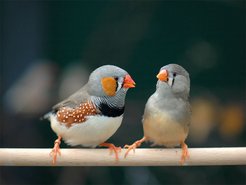"Casanova gene" in female songbirds
Female zebra finches inherit "infidelity gene" from their fathers
It is assumed that many bird species are monogamous, yet infidelity is a widespread phenomenon. The advantage for the male seems obvious as in this way he can increase the number of his offspring. A female, however, mostly faces costs. The cuckolded partners often reduce their parental care. In addition, the extra lovers also may transmit diseases. Nevertheless, some females actively seek such contacts. Researchers at the Max Planck Institute for Ornithology in Seewiesen investigated a large number of zebra finches and found a possible explanation for this behaviour. In a genetic long-term study they found that females inherit the disposition for their infidelity from their fathers (PNAS, online publication June 13, 2011).

For quite some time it was common thinking that most bird species lead a strictly monogamous way of life. Yet, using molecular genetic methods scientists have found over the past 20 years that many juveniles do not originate from their social fathers. Initially, the explanation for these extra-pair paternities seemed plausible. The males could enhance their reproductive success through a higher number of offspring and females received high quality genes when they were keeping an eye out for attractive mates.
Recently, scientists have cast doubt on this explanation as the actual benefits for the females were not as high as expected by theory. To the contrary, the negative aspects even prevailed. The cuckolded males often reduce their parental effort and also support from extra-pair mates cannot be expected because they rather help their own mate. Therefore the question remained as to why some females actively seek other males for extra-pair matings.
Behavioural ecologist Wolfgang Forstmeier and colleagues at the Max Planck Institute for Ornithology in Seewiesen have now found a possible explanation for this phenomenon. Within a period of eight years the researchers investigated the sexual behaviour of over 1500 zebra finches. At first, unmated male and female birds were subjected to a test of their sexual motivation or libido. Afterwards a subset of the finches was transferred into aviaries in order to test how socially monogamously mated individuals behaved to each other within a large group. Using a video surveillance system the researchers could observe how mated females were reacting to advances of their own partner and of stranger males. In addition, the researchers conducted genetic paternity analysis by using a microsatellite marker method in order to determine the number of offspring that a male had sired in a foreign nest. They also indentified the number of offspring that a female produced together with an extra-pair male.
The result was surprising. Apparently the readiness of females to engage in extra-pair contacts was inherited from their fathers that had been cheating on their partners as well. The predisposition for infidelity shows a moderate, but evolutionarily crucial, genetic basis. Since the readiness for infidelity is passed on from the fathers to the daughters the researchers arrived at a new interpretation of female infidelity. “It is not essential that there is an evolutionary benefit for the females”, says Wolfgang Forstmeier, author of the study. “It is rather sufficient that the male ancestors had benefits that resulted from their promiscuity. A “Casanova-gene” will increase its frequency within a population as long as the benefits to the male gene carriers outweigh the costs for the female gene carriers”.
Whether the hypothesis of a correlated evolution of male and female infidelity can be transferred to the situation in humans is still open for speculation. There is no doubt, however, that there is a genetic basis for many aspects of human sexual and pair-bonding behaviour. “The question to what extent it is the same genes that influence female and male behaviour in a similar way has to be answered in follow-up studies”, says Forstmeier.
SL/WF/BA
